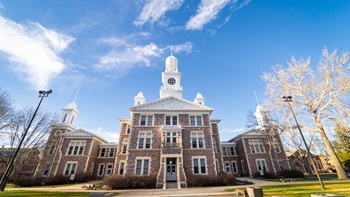Educating South Dakotans, Serving South Dakota

With nine health education-focused departments, 22 programs and two significant public service centers, the School of Health Sciences is the largest and most comprehensive source of teaching and clinical preparation in South Dakota’s spectrum of higher education institutions that produce skilled practitioners in health professions.
Many of USD’s health care programs are unique to South Dakota, as they are offered only through USD’s School of Health Sciences.
Between 2009 and the summer of 2019 the School of Health Sciences, through these nine departments and their programs, granted more than 4,400 degrees in health-related programs and studies. Sixty-three percent of those individuals – approximately 2,800 graduates – are working and/or living in South Dakota.
4,400 people have earned degrees from the USD School of Health Sciences during the last decade. 63% live and/or work in South Dakota.
The school is a national leader in the influential movement to integrate “interprofessionalism” into contemporary health care education and clinical practice. Interprofessional health care emphasizes interdisciplinary partnerships and collaboration among health care providers to better serve patients and communities. Because the school encompasses an array of programs and departments, students within those programs and departments are able to interact and learn about interprofessionalism within health care, preparing them for real-world applications of this vital approach.
The school and its students also benefit by a working relationship with USD’s Sanford School of Medicine – the state’s only school of medicine – and the many interprofessional opportunities that this relationship affords health sciences students. The School of Health Sciences has been at the forefront of the interprofessional health care movement for a number of years and has contributed national leadership to this movement.
Telemedicine and other technological communication tools in health care have been gaining practical, beneficial applications since the 1990s, with the School of Health Sciences at the forefront of this technological evolution. Not only are students participating in and learning about health care expertise and information delivered via technology across distances, they are learning about its particular benefits to rural and underserved locations in South Dakota. The school recently became the second “hub” of the significant ECHO telementoring system in South Dakota, allowing health experts at USD’s School of Health Sciences to serve underserved and rural areas of South Dakota with mentoring and guidance.
Research projects within various departments at the school continue to attract significant financial support and generate meaningful results that improve health care outcomes for the public. Total awards in FY 2019 for ongoing research was nearly $1.3 million. Also during FY 2019, 11 research projects valued at $4.9 million have been submitted and are awaiting approval. Sources for research support are diverse, including the federal Health and Human Services agency, South Dakota’s departments of Health, Social Services and the Governor’s Office of Economic Development, Sanford Research, the Bush Foundation, the Association of Social Work Boards, South Dakota Community Foundation and others are on the list.
Nearly all departments within the school are engaged in research endeavors, with the Department of Nursing leading the way. Research opportunities are not confined to graduate students in the school. Undergraduate opportunities are expanding, and are proving increasingly useful to student education and skillset preparation.
Nationally, health care occupations employment is projected to grow 18% from 2016 to 2026, much faster than the average for all occupations, and this will add about 2.4 million new jobs across the United States. Health care occupations are projected to add more jobs than any other occupational groups." - from the U.S. Department of Labor
Nursing has designed a formal program, Pathway to Innovation, that provides undergraduates with prospects to explore and confirm their interest in research. This 240-hour program can be completed during one highly focused summer or spread out over two or three semesters. No other nursing program in South Dakota offers its undergraduate students such an opportunity.
Enrollment in health sciences departments and programs is strong, and the school is one of the largest within the USD family. In 2018, 2,399 students were enrolled in the various programs and directed, pre-enrollment preparatory coursework offered by the School of Health Sciences. Included in that number were 485 students enrolled in graduate-level programs, and 1,914 students participating in undergraduate health programs.
South Dakotans make up the majority of students, with 1,507 state residents enrolled. Iowa, with 227 students and Minnesota, with 210, follow behind. Nebraska residents number 122 among those enrolled in the school health programs.
Diversity is also reflected in the 2018 data. In the fall of 2018 there were 98 Hispanic/Latino students enrolled in programs at the School of Health Sciences, 70 African Americans/blacks and 48 Native Americans. Women comprise the majority of health sciences students, with 2,006 females and 393 males enrolled in those health programs. In 2018, 60 students earned doctorate-level degrees and 100 students earned master’s degrees from the USD School of Health Sciences.
Delivering well-prepared professionals with advanced degrees is a distinguished hallmark of the School of Health Sciences and reflects the school’s impressive faculty in all programs.
Community Service
Community service activities involving hundreds of students and faculty of various programs within the School of Health Sciences are numerous and widespread.
They range from Adopt-a-Highway activities involving physical therapy students to fundraising for the Vermillion Food Pantry, Feeding South Dakota and The Banquet in Sioux Falls by social work students, to students from a variety of departments volunteering at community health information and clinical sessions in schools, shopping malls, retail stores, Head Start facilities, senior citizen centers and nursing homes. Most of these activities happen in South Dakota. Some occur in our region, including adjacent states, and some happen in international locations, in places like Guatemala, where students from a variety of disciplines travel to serve dramatically underserved residents.
Consider the clinical and community services provided by just one department, dental hygiene. Not only are dental hygiene students able to learn and improve their skills through clinical-service activities, they contribute to improving health care for those members of the public who visit the clinics and wellness activities. Each school year is carefully scheduled. During the 2018-2019 school year, for example, students from the dental hygiene program visited schools and served students in Alcester-Hudson, Avon, Beresford, Bridgewater-Emery, Canton, Centerville, Elk Point-Jefferson, Ethan, Freeman, Irene-Wakonda, Lennox, Worthing, Marty Indian, Montrose, Parker, Parkston, Scotland, Tripp-Delmont, Vermillion’s Austin and Jolley Elementaries and Viborg-Hurley. They visited nursing homes in Alcester, Centerville, Yankton and Viborg, and senior centers in Centerville, Beresford and Yankton.
Dental hygiene students also provided services at a variety of wellness events, health fairs, Special Olympics events and other public activities. A collaborating dentist travels to some of these locations to accompany students and add services to the clinic. Students also performed service at their own clinic, the USD Dental Clinic, in Sioux Falls. Rewarding, meaningful community service opportunities such as these are available for students in departments throughout the School of Health Sciences.



